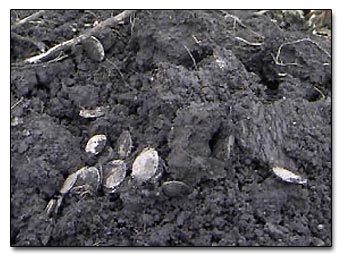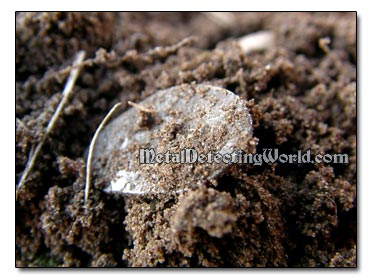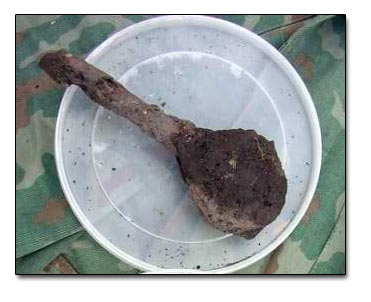Cache Hunting Tips: Search and Recovery Technique
How To Find a Coin Hoard in the Farm Field - Tutorial, page 1
This method is applicable only for the farm fields that are plowed annually. These days, many fields encompass the sites of old settlements that flourished once but, for many reasons, disappeared forever in the past. The proof of their former existence could be found either on the old maps or in the form of a cultural layer - fragments of bricks, pottery, and foundation stones scattered on the ground in farm fields. That is where a discovery of the coin cache can be just "a piece of cake."
The coin caches are usually buried no deeper than the arm's length for the purpose of easy and fast retrieval. The treasures could be placed into any container, either metal or nonmetal. More general info on cache hunting is on my Cache Hunting page.
In my treasure hunting experience, all coin caches that I discovered were just stacks of coins in dirt. That would indicate that the coins were placed into a wooden keg, stocking or just a sock which had disintegrated over a long period of time.
To discover a buried treasure that was placed into an iron pot is both hard and easy at the same time. That would require a different way of thinking, more patience and time, and more meticulous method of searching.
To search and recover buried stacks of coins is much easier as a good part of the job would have been already done by the annual field plowing and natural processes.
What usually has been taking place over many years is simple. Initially, a field plow would hit an upper part of the coin stack, catch a cluster of coins from it, and bring it up closer to the ground surface. The subsequent field plowings would intersperse the coins in soil and move them further away from the cache's core and up to the surface.

Many winter frosts would finally finish the job by pushing the coins out of the ground, thus, creating a "coin-scatter" (also called "coin spread" and "coin disperse") - a "hot" spot, approximately 10 yards by 5 yards, consisting of 20 - 40 coins scattered on the ground and laying right on the surface. Usually the shapes of coin-spreads come in two basic patterns: rhomboid or oval.
When you discover a coin-spread in the field, it is very important that you determine its pattern. That would be helpful in pinpointing the cache. The best way to see the pattern is to mark the spots or not to cover the holes that yielded the coins before you recover the last coin of the coin-spread.
When you are recovering the coins at the coin-spread spot, dig up every signal, no matter if it is good or bad! Many of the smaller coins are always "suspended" in soil in various positions - on the edge or leaning at different angles, due to the annual plow movements. Such coins usually give out mixed or bad signals. The rule is to dig ALL signals in order to catch that one, almost faint - a signal coming from the coin hoard buried just at the verge of your machine's detecting range.
After you would have dug up the last coin, make sure no more coin signals left at the spot. Even if you have not gotten the faint signal from the hoard itself, you would be still able to use the pattern of the coin-spread's shape for pinpointing a treasure cache. If the coin-spread has a rhomboid shape, the middle point of the rhombus would be the location of a cache's core situated deep below. If the shape of the coin-spread is oval, pinpointing the hoard's core gets a little tricky.
To pinpoint the hoard's core in this case, you need to determine whether the oval's longer axis (a straight line with respect to which an oval is symmetrical) is aligned with the direction of plowing in the field or not. If the oval's long axis is aligned with plowing lines, either vivid (the furrows) or slightly visible, the hoard's core would be at the oval's center. If the oval is positioned in such a way that its long axis crosses the lines of plowing at the 30-60 degrees angle, the hoard's core could be located at either end of the oval, depending on which way (only one way) the plow had been moved in this field for years.
If the buried cache is inside the iron pot Another way to pinpoint the cache is to look for a large iron signal. That would require both the use of All Metal mode or zero Discrimination and a larger Search Coil.
But be prepared to dig up a lot of iron junk of medium and large sizes, which is buried close to the surface! Unfortunately the convenient metal detectors are calibrated for the coin-size targets only, that is why it is not possible to determine the depth of the buried iron junk if it does not give out a "big" or "wide" signal during pinpointing.
And you will be digging up lots of deep-buried iron objects if you use a deep-seeker such as Pulse Star II Pro or any model of Lorenz - the Pulse Induction detectors. They are ideal for cache hunting but require a strong stamina and two or three persons to do the job effectively.
Out of being superstitious, a person who buried a cache would also place a Cache-Protector (obereg), usually an iron padlock or door bolt, sometimes a small or pectoral icon made of bronze or copper, on top of the cache. In medieval times, it was believed that a Cache-Protector would prevent the treasure from being discovered by others.
Ironically, a few centuries later, the iron cache-protector of a large size has become a true protector against any metal detector: it fools the machine by masking the loot buried underneath as if it is an iron object. It happens even after the cache-protector had been moved a little by the plow.
This Iron Junk "Whatsit" Was A Cache-Protector Too

Unless the cache-protector had been moved further away from the treasure by field plowing, the cache would be missed by an inexperienced treasure hunter. It is wise to scan the entire area of the coin-spread with a metal detector set up in All Metal Mode and on highest Sensitivity in order to retrieve all iron targets from the spot, possibly find the iron obereg and then hear the faint signal coming from the coin cache itself.